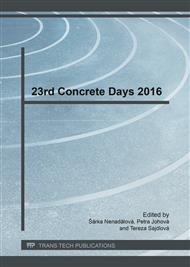[1]
A. M. Nevile, Properties of Concrete, Pearson Education Limited, Harlow 2011, 846.
Google Scholar
[2]
H. Šimonová, I. Havlíková, P. Daněk, Z. Keršner, T. Vymazal, The Effect of a Superplasticizer Admixture on the Mechanical Fracture Parameters of Concrete, Mater. Tehnol., 49 (2015) 3, 417−421, doi: 10. 17222/mit. 2014. 114.
DOI: 10.17222/mit.2014.114
Google Scholar
[3]
H. Šimonová, L. Topolář, I. Havlíková, M. Matysík, P. Daněk, Z. Keršner, Evaluation of Three-point Bending Fracture Tests of Selected Concrete: Crack Initiation and Acoustic Emission Parameters, ibidem.
DOI: 10.4028/www.scientific.net/ssp.259.58
Google Scholar
[4]
B. L. Karihaloo, Fracture Mechanics and Structural Concrete, Longman Scientific & Technical, New Yotk, (1995).
Google Scholar
[5]
D. Novák, D. Lehký, ANN inverse analysis based on stochastic small-sample training set simulation, Engineering Application of Artificial Intelligence, 19 (2006) 7, 731–740, doi: 10. 1016/j. engappai. 2006. 05. 003.
DOI: 10.1016/j.engappai.2006.05.003
Google Scholar
[6]
T. Komárková, M. Králíková, D. Kocáb, P. Misák P., T. Stavař, Comparison of Standardized Test Methods for Determining the Permeability of the Surface Layer of Concrete, Advanced Materials Research, 1122 (2015).
DOI: 10.4028/www.scientific.net/amr.1122.141
Google Scholar
[7]
T. Komárková, M. Králíková, P. Kovács, D. Kocáb, T. Stavař, Application of computed tomography in comparison with the standardized methods for determining the permeability of cement-composite structures, Mater. Tehnol., 49 (2015).
DOI: 10.17222/mit.2014.194
Google Scholar
[8]
RILEM TC-50 FMC (Recommendation): Determination of the fracture energy of mortar and concrete by means of three-point bend test on notched beams, Materials & Structures, 18 (1985), 285–290.
DOI: 10.1007/bf02472918
Google Scholar
[9]
V. Červenka, L. Jendele, J. Červenka, ATENA Program documentation – Part 1: Theory, Cervenka Consulting, Prague, (2015).
Google Scholar
[10]
D. Lehký, Z. Keršner, D. Novák, FraMePID-3PB software for material parameter identification using fracture tests and inverse analysis, Advances in Engineering Software, 72 (2014), 147–154, doi: 10. 1016/j. advengsoft. 2013. 10. 001.
DOI: 10.1016/j.advengsoft.2013.10.001
Google Scholar
[11]
R. Ince, K. E. Alyamac, Determination of fracture parameters of concrete based on water-cement ratio, Indian Journal of Engineering & Material Sciences, 15 (2008), 14–22.
Google Scholar
[12]
P. J. M. Monteiro, P. R. L Helene, S. H, Kang, Designing concrete mixtures for strength, elastic modulus and fracture energy, Materials and Structures, 26 (1993) 8, 443–452, doi: 10. 1007/BF02472804.
DOI: 10.1007/bf02472804
Google Scholar


